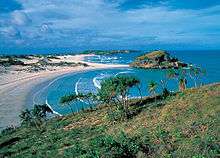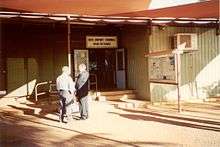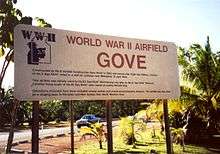Gove Peninsula
The Gove Peninsula is at the northeastern corner of Arnhem Land in the Northern Territory of Australia. The peninsula became strategically important during World War II when a Royal Australian Air Force base was constructed at what is now Gove Airport. The peninsula was involved in a famous court case known as the Gove land rights case, when local Yolngu people tried to claim native title over their traditional lands in 1971, after the Australian Government had granted a mineral lease to a bauxite mining company without consulting the local peoples. Today the land is owned by the Yolngu people.
| Gove Peninsula Northern Territory | |
|---|---|
 Gove Peninsula | |
| Coordinates | 12°17′0″S 136°49′0″E |
Location

The Gove Peninsula is on the west coast of the Gulf of Carpentaria within Arnhem Land, a vast tract of Aboriginal-owned land on the Northern Territory coastline. The township of Nhulunbuy is the main commercial and service centre of the Peninsula and is 600 kilometres east of Darwin.
History
Modern
As Europeans started land exploration throughout the Northern Territory and subsequently settled closer to Yolngu homelands, conflicts with the Yolngu became more frequent. In 1931, an area of 96,000 square kilometres (37,000 sq mi) was proclaimed as an Aboriginal reserve, named Arnhem Land Aboriginal Reserve.[1]
Land on the peninsula was famously part of the 1971 Milirrpum v Nabalco Pty Ltd, aka the Gove land rights case, a milestone in the history of Indigenous land rights in Australia.[2][3] The plaintiffs, elders of various clans of the local Yolngu people, claimed they enjoyed sovereignty over their land, and sought the freedom to occupy their lands.[4] The ruling went against them, as native title in Australia had not yet been recognised, but the principles on which the case were based were overturned in the Mabo case 21 years later.[3]
Today the Land Trust holds about 100,000 square kilometres (39,000 sq mi) as Aboriginal freehold land (with the exception of mining leases).[1]
The Gove Peninsula was heavily involved in the defence of Australia during World War II. Three operational air squadrons were based there at an airfield on the site of the present Gove airport and at a flying boat base at Drimmie Head. The Peninsula derives its name from a RAAF navigator who died in a mid air collision.[1]
Demographics
On the night of the 2001 Census there were 13,080 people living in the "Indigenous region" of Nhulunbuy, which covers most of the Gove Peninsula. Of these 60.7% were Aboriginal people.
| Population | Percentage | |
|---|---|---|
| Total Persons | 13,080 | - |
| Total Indigenous persons | 7,940 | 60.7% |
| Males | 3,905 | 49.2% |
| Females | 4,035 | 50.8% |
On the night of the 2001 Census there were 3,766 people living in the "Urban Centre" of Nhulunbuy. Of these 7.3% were Indigenous.
| Population | Percentage | |
|---|---|---|
| Total Persons | 3,766 | - |
| Total Indigenous persons | 275 | 7.3% |
| Males | 2,135 | 56.7% |
| Females | 1,631 | 43.3% |
Based on a 2004 NT Government Socio-Economic Snapshot, there is a population of 14,115 within the Gove Peninsula (East Arnhem Region), of which almost 64% are Indigenous people, and a population of nearly 4,000 in Nhulunbuy, the majority being non-Indigenous people. Those people not living in Nhulunbuy live in surrounding communities and traditional homelands. In the five years to 2004, the population declined in Nhulunbuy and Groote Eylandt and increased in the non-urban areas.
At the 2016 census, Nhulunbuy SSC (urban area) had a population of 3,240, with a median age of 32. Only 2.8% were Indigenous.[5] Nhulunbuy Indigenous region had 9,559 Aboriginal and/or Torres Strait Islander residents, with 97.7% of these Aboriginal, 0.5 Torres Strait Islander, and 1.9% both.[6]
Yolgnu people
Owned by the traditional Aboriginal owners, the Yolngu people, it is a place rich in culture with Yolngu maintaining strong ties with their land, religion and traditions.
Rather than the name of a clan or family group, Yolngu is the word that Aboriginal people from East Arnhem Land, including the Gove Peninsula, use to refer to themselves. The main five clan groups of the region are Gumatj, Rirratjingu, Djapu, Madarrpa and Dhalwangu.[7]
Any non-Yolngu person is called a Balanda (thought to originate from the word 'Hollander' for a Dutch person).[8]
Geography and climate
Topography and climate
Situated just 12 degrees south of the Equator, the Gove Peninsula has a monsoon climate. The non-Aboriginal people of the Northern Territory tropics recognise two distinct seasons, the dry season from May to October, and the wet from November to April. During the dry, temperatures range from 15 to 18 degrees Celsius at night to 28 to 30 degrees Celsius during the day. There is virtually no rainfall, clear blue skies and cool ocean breezes. The wet season brings the monsoon weather with hot and humid days ranging from 31 to 35 degrees Celsius and warm nights.[7] Electrical storms are spectacular and there can be cyclonic activity. Humidity is high and rainfall averages between 100 and 300 milli-metres per month with an annual rainfall around 1100 milli-metres.[9]
Yolngu however recognise eight seasons derived from changing behaviours and patterns apparent in the land, flora and fauna as follows. Dhuludur (‘the Pre-wet season’, October–November) when the weather is erratic, ‘female’ thunder and lightning storms are frequent, turtles and Threadfin Salmon are hunted, and the ‘male’ thunder shrinks the waterholes. Bärra’mirri (‘the season of Heavy Rain and Growth’, December–January) when there are heavy rains and prolific plant growth, the Magpie Geese arrive and shellfish are harvested. Mayaltha (‘the Flowering season’, February–March) when there are bright sunny days but little bush tucker, flies arrive and mosquito larvae are abundant in the pools. Midawarr (‘the Fruiting season’, March–April) when the east wind signals a time of abundant bush foods, including fruits, nuts and barramundi. Ngathangamakulingamirri (‘a two-week Harvest season’, April) Dharratharramirri (‘the Early Dry season’, May–July) when the trade winds (south-southeast) arrive, the bush is fired, Magpie Lark flocks arrive and sharks and stingrays give birth. Burrugumirri (‘the time of the Birthing of Sharks and Stingrays’, three weeks in July to August) Rarrandharr (‘the Main Dry season’, August–October) when warm southeast winds blow, the soil is hot, young sharks and stingrays are hunted, and the stringybark flowers. National Oceans Office, 2003, Snapshot of the Northern Planning Area, Hobart.[10]
The Gove Peninsula is barely touched by western development, with the exceptions of Nhulunbuy and the bauxite mine and alumina refinery. There are vast tracts of unspoilt land, beaches and ocean. The land is characterised by a mixture of savannah woodland, wetlands and patches of monsoon forest and rocky escarpment. The beaches, bays and islands are idyllic with stretches of beautiful white sand and clear blue ocean waters. Some favourite destinations of locals and visitors alike are Nanydjaka (Cape Arnhem), Lurrupukurru (Oyster Beach), Rangura (Caves Beach), Baringura (Little Bondi), Ngumuy (Turtle Beach), Garanhan (Macassan Beach), and Daliwuy (Daliwoi Bay).
There are three marked coastal walking trails, providing relatively short and pleasant walks. These are Daliwuy to Garanhan (3 km, red trail marker), Garanhan to Ngumuy (2.5 km, yellow trail marker) and Ngumuy to Baringura (1.5 km, black trail marker). Yolngu elders have provided interpretive material along the way so visitors can enjoy and appreciate their rich culture and beliefs.[8]
Government
There are 10 local councils in the region which administer the townships of Nhulunbuy and Angurugu and a number of local communities that primarily service Indigenous people.
Economy
Nhulunbuy is a purpose built town developed by the former owner of Alcan Gove (Nabalco), a huge bauxite mine and now closed alumina refinery 15 kilometres away. The town is built on a Special Purpose Lease on Aboriginal land and is now the largest town in East Arnhem Land, the fourth largest town in the Northern Territory and the administrative centre for the region.[7]
The market economy of the Gove Peninsula is centred on the Alcan Gove Mine which is located on leasehold land within the boundaries of Aboriginal freehold land. In November 2013 Rio Tinto announced the closure of the mine associated alumina refinery (but not the bauxite mine) in July 2014 with the loss of 1,100 jobs, or almost 25% of the town's population.[11] The population had already dropped by mid 2014, with some of the workforce retained to monitor the shutdown and survey holding ponds full of toxic compounds but most will be gone by January 2015.[12] A range of measures were announced to support the town and its former workers through the closure and the following three years, but locals anticipate further cuts to services since the school, hospital, power plant and flights were backed by Rio Tinto.[13] The closure of the mine also left flights on the Darwin-Nhulunbuy route to fall to around 50-60% full, causing Qantas to suspend flights on the route from 17 August 2015.[12]
The Commonwealth Government carried out mineral explorations in the 1950s and was successful in discovering a bauxite deposit that covered 65 square kilometres (25 sq mi) and contained an estimated 250 million tonnes. After initial resistance to mining by the government Nabalco was set up and was granted a lease with a commitment to build a township, port facility and mine. The construction of the mine lead to the Gove land rights case (see above), which initially resulted in ruling in favour of the mineral company.
Transport

It is possible to hire four wheel drives, conventional vehicles or bicycles in Nhulunbuy and an airport bus and taxi company service the town.
Air

The Gove Airport is located 13 km from the town centre of Nhulunbuy. Qantas and AirNorth have a daily flight to Gove from Cairns and Darwin which then connect to cities around the world. The Cairns – Gove flight is 1 hour and 40 minutes duration and Darwin – Gove is 1 hour and 10 minutes.[14]
Road
The most direct route to Nhulunbuy from a major Highway is via the Central Arnhem Road which leaves the Stuart Highway 52 km south of Katherine. The first 30 kilometres are sealed and then the rest is a gravel road. A four-wheel-drive vehicle is recommended, particularly for the two major river crossings, the Wilton River near Bulman Aboriginals Community and the Goyder River, about 300 kilometres from Nhulunbuy. Fuel needs to be carried as travellers may not be able to purchase fuel along the way. The Central Arnhem Road is 682 kilometres long, plus the 52 kilometres from Katherine to the turnoff makes a long drive, approximately 8 or 9 hours drive with good conditions. Travellers require a permit as the road runs across many Yolngu Clan lands.
Education
Nhulunbuy has one public primary school, which incorporates pre-school, and one public secondary school which provides education to a Year 12 level. There is also a private school, Nhulunbuy Christian School, which provides education from Transition to Year 10. Yirrkala has a school which supports further afield community schools.
Society and culture
Yolngu culture and ties to the land are still very strong and sacred. Many people still live mainly a traditional life. Each August, Gulkula near Nhulunbuy, holds the Garma festival. This is a celebration of Yolngu culture is considered one of the most important indigenous festivals in Australia. Around 2,000 Indigenous and non-Indigenous people travel from around Australia and the world to attend the festival to learn and contribute. Garma is a Yolngu word for ‘two-way learning process’. There is traditional and contemporary music and dance, art and craft, education, performances and sport. Art and craft is gaining worldwide recognition and is an opportunity for Yolngu to gain economic independence. The Gove Peninsula has three outstanding art centres, Nambara Arts and Crafts near Nhulunbuy, Buku Larrngay Mulka in Yirrkala and Elcho Island Art and Craft. The artists of North East Arnhem continue to paint their sacred designs using ochres on bark. This not only reflects the sanctity of their connection with the land they paint but an artistic discipline that is recognised internationally.[8]
Music
Arnhem Land, including the Gove Peninsula, is home to what is commonly referred to as the didgeridoo, known as the yidaki locally, and Yolngu are master players and craftsmen of the instrument. In this region, the rhythms, techniques and compositions endemic to the people are of outstanding musical interest.
Didgeridoos from north-east Arnhem Land are instruments of the highest cultural integrity. The use of the didgeridoo in this part of Australia continues as an unbroken tradition since time immemorial. In recent times, the Yothu Yindi band and Djalu Gurruwiwi - "Mr Didgeridoo" - has done much to popularise the yidaki around the world. Yidaki are commonly made in north-east Arnhem Land from gadayka - Eucalyptus tetradonta or Stringybark, gungurru - Eucalyptus miniata or Woolybutt, and badawili - Eucalyptus ferruginea or Rusty Bloodwood.[15]
Sport and recreation
Sport is a big part of the lives of people in Nhulunbuy and there are facilities including a sports ground, golf course, yacht club, swimming pool, fishing club, surf-lifesaving club, speedway and skate park.
Sailing
Gove Harbour is a popular stop off point for yachts sailing the northern coast of Australia or heading to the countries to the north of Australia and beyond. Apart from the months of December to April when cyclones can affect the coast line, the waters surrounding the Gove Peninsula provide excellent sailing conditions. The Gove Boat Club is often packed full of visiting yachties from all over the world and the club often holds regattas and other annual events.
Diving
Diving the colourful and rich coral reefs in the clear waters offshore from Gove is becoming more and more popular. There is drift, deep and multi-level diving available and many reefs and offshore islands to explore. There are two reputable dive companies in Nhulunbuy who offer dive tours and short courses.
See also
References
- "History". East Arnhemland. Archived from the original on 27 June 2007. Retrieved 5 June 2007.
- Wong, Tammy (2019–20). "Blackburn's "error": The Ngaliwurru Nungali (Timber Creek) Caseand the future of compensation in native title" (PDF). State Chambers.CS1 maint: date format (link)
- Fogarty, John; Dwyer, Jacinta (2012). "The First Aboriginal Land Rights Case". In Sykes, Helen (ed.). More or less: democracy & new media (PDF). Future Leaders. ISBN 9780980332070.
- "Milirrpum v Nabalco Pty Ltd (1971) 17 FLR 141". ATNS (Agreements, Treaties and Negotiated Settlements project). University of Melbourne. Retrieved 26 July 2020.
- "2016 Census QuickStats: Nhulunbuy [SSC]". Australian Bureau of Statistics. Retrieved 26 July 2020.
- "2016 Census QuickStats: Nhulunbuy [IREG]". Australian Bureau of Statistics. Retrieved 26 July 2020.
- "Alcan Gove. Investing in the Northern Territory", www.alcangove.com, Alcan, archived from the original on 28 September 2007
- Gove East Arnhemnland Tourism
- Police internet site
- http://www.environment.gov.au/coasts/mbp/publications/pubs/northern-snapshot.pdf
- McGrath, Pat (29 November 2013). "About 1,100 jobs cut as Rio Tinto suspends production at Gove alumina refinery in the Northern Territory". ABC Online. Retrieved 12 Feb 2014.
- Milman, Oliver (11 August 2014). "Boom and dust: uncertain future for the mining town run by Rio Tinto". the Guardian. Retrieved 26 July 2020.
- McGrath, Pat (29 November 2013). "Rio Tinto reveals rescue package for future of Nhulunbuy after alumina refinery closure". ABC Online. Retrieved 12 Feb 2014
- Australia Total Travel Guide - Accommodation, Tours, Flights & Maps Archived 2007-06-03 at the Wayback Machine
- North-east Arnhem Land Didgeridoos |iDIDJ Australia Archived 2007-08-14 at the Wayback Machine
External links
| Wikimedia Commons has media related to Gove Peninsula. |
- Gove Online - An e-newspaper dedicated to Nhulunbuy on the Gove peninsula, and this remote East Arnhem Land region. Includes news, articles, community notices and events.
- Northern Territory Tourist Information Site